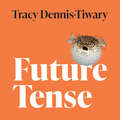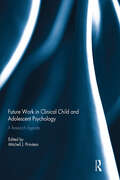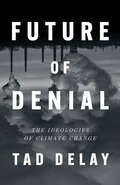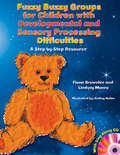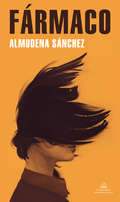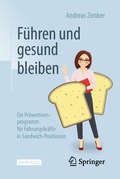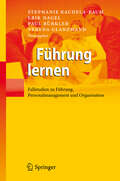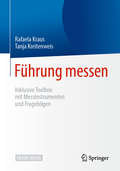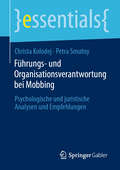- Table View
- List View
Future Tense: Why Anxiety is Good for You (Even Though it Feels Bad)
by Tracy Dennis-TiwaryA psychologist confronts our pervasive misunderstanding of anxiety and presents a powerful new framework for reimagining and reclaiming the confounding emotion as the advantage it evolved to be.We are taught that anxiety is dangerous and damaging, and that the solution to its pain is to eradicate it like we do any disease. Yet cutting-edge therapies, hundreds of self-help books, and a panoply of medications have failed to keep debilitating anxiety at bay.That's because the anxiety-as-disease story is false - and it's harming us.In this radical reinterpretation, Dr Tracy Dennis-Tiwary distils the latest research in psychology and neuroscience, combined with real-world stories and personal narrative, to argue that the discomfort of anxiety is a tool, rather than something to be stamped out at all costs. Detailing the terrible cost of our misunderstanding of anxiety, while celebrating the lives of people who harness it to their advantage, FUTURE TENSE reveals how we can live and grow with anxiety.
Future Time Perspective and Motivation: Theory and Research Method
by Joseph NuttinFirst published in 1985. Routledge is an imprint of Taylor & Francis, an informa company.
Future Work in Clinical Child and Adolescent Psychology: A research agenda
by Mitchell J. PrinsteinPreeminent clinical child and adolescent psychological scientists offer an agenda for future research in this compendium of thought pieces. On a wide range of topics including ADHD, depression, self-injury, emotion regulation, conduct problems, addictions, clinical assessment and therapy, and many more, scientists review the current state of the literature and offer specific recommendations for what investigators next need to tackle to reduce mental illness among youth. Chapters include a discussion of theories and methods in clinical child and adolescent psychology, current funding priorities, and the intersection of traditional clinical psychology research with the burgeoning field of psychological neuroscience. This book is an essential resource for classes on clinical child and adolescent psychopathology and treatment. It also provides a unique guide for undergraduate and early graduate students who are determining how to start their research careers in the field. All of the chapters in this book were originally published as articles in the Journal of Clinical Child and Adolescent Psychology.
Future of Denial: The Ideologies of Climate Change
by Tad DeLay"Tad DeLay is one of the most important and disquieting theorists of consciousness and politics writing today. His work is indispensable."—China Miéville, author of OctoberCapitalism is an ecocidal engine constantly regenerating climate change denialThe age of denial is over, we are told. Yet emissions continue to rise while gimmicks, graft, and green- washing distract the public from the climate violence suffered by the vulnerable. This timely, interdisciplinary contribution to the environmental humanities draws on the latest climatology, the first shoots of an energy transition, critical theory, Earth&’s paleoclimate history, and trends in border violence to answer the most pressing question of our age: Why do we continue to squander the short time we have left?The symptoms suggest society&’s inability to adjust is profound. Near Portland, militias incapable of accepting that the world is warming respond to a wildfire by hunting for imaginary left-wing arsonists. Europe erects nets in the Aegean Sea to capture migrants fleeing drought and war. An airline claims to be carbon neutral thanks to bogus cheap offsets. Drone strikes hit people living along the aridity line. Yes, Exxon knew as early as the 1970s, but the fundamental physics of carbon dioxide warming the Earth was already understood before the American Civil War.Will capitalists ever voluntarily walk away from hundreds of trillions of dollars in fossil fuels unless they are forced to do so? And, if not, who will apply the necessary pressure?
Fuzzy Buzzy Groups for Children with Developmental and Sensory Processing Difficulties
by Fiona Brownlee Lindsay MunroChildren with sensory and cognitive difficulties can struggle to interact with their peers, be easily distracted, and have problems coping with change. Fuzzy Buzzy Groups for Children with Developmental and Sensory Processing Difficulties has been devised to address the needs of children with sensory processing difficulties and development delay in specialist and inclusive settings. This easy-to-follow resource will enable professionals to engage with children in a relaxed and fun way that explores sensory experiences. It contains everything you need to run a Fuzzy Buzzy group: from advice for choosing sensory food and drink and criteria for selecting suitable children, to tips for involving parents in the group and sourcing sensory materials. The authors guide you step-by-step through how to carry out a session, and include photocopiable forms and checklists as well as a sing-along CD containing music to use with the group. This resource will help children not just to explore sensory experiences, but also to learn to share, take turns, listen, interact with their peers and improve their self-esteem. The eight-session programme is ideally suited to children aged 2-5, although this can be adapted to suit individual needs, and is perfect for early years' practitioners, teachers, teaching assistants, family respite carers and other professionals working with young children.
Fármaco
by Almudena SánchezUn testimonio sobre la depresión escrito sin tabúes, con humor y cercanía por una de las voces más especiales de su generación. «Almudena Sánchez hace música con los añicos de ese cristal delicado del que estamos hechos.»Elvira Navarro Este es el relato de una explosión, del momento en que la tristeza dinamitó todas las certezas de la autora y decidió instalarse en su cuerpo. En Fármaco encontraréis un cerebro que quería desaparecer y una escritora que lo agarró y buscó cómos y porqués entre recuerdos, conductos y cavidades. Aquí hay infancia y hay madre, una niñez en escuelas de Mallorca y en campos de Castilla; hay pastillas naranjas que te ponen en pausa y pastillas rojas que te lanzan a la estratosfera; hay sueños, pesadillas y deseos: «ojalá la depresión se quitara desnudándonos, tímidamente y despacio». Y libros. Hay muchos libros, historias para escapar y otras para entender qué pasaba en su cabeza. Aquí la literatura es bálsamo, esperanza y salvación. La crítica ha dicho...«"Este libro es para personas tristes con sentido del humor", escribe Almudena Sánchez. Desde luego, Fármaco no es un texto para personas alegres que carezcan de él. El relato de la depresión se solapa con los recuerdos de infancia a los treinta y tres años. Sánchez es una Charlie Rivel y una Jesucrista Superestar que escribe, con ligereza, sobre un peso insoportable, y nos regala un libro honesto, limpio y maravilloso.»Marta Sanz «Como quien afila una mina de lápiz muy oscura para hacerla punzante y obtiene a la vez virutas de luz, así escribe en este libro Almudena Sanchez. No necesita excederse en la crudeza ni tampoco idealizar, escribe con distancia y temblor, abate cada prejuicio, enciende sombras.»Belén Gopegui «Un libro que se hace al mismo tiempo que la vida. En Fármaco cada símbolo esconde una historia, con su pasado y su presente. En la prosa de Almudena Sánchez, el futuro es la belleza.»Elena Medel Sobre La acústica de los iglús se dijo:«Sánchez salta a la comba contra la desdicha, pero no es un juego. Ella escribe con un esmerado desorden. ¿Con el esmerado desorden de los que intentan qué? Es posible que no envejecer.»Isabel González, El Mundo «Si acaso es posible la quimera de una adolescencia adulta, de una madurez jovial, los relatos de Almudena Sánchez apostarían todo a esa ensoñación, pues en ellos encontramos la mirada única de una narradora que templa el estilo para poner del revés la trama mágica del mundo.»Eñe «Pero su humor no es sólo satírico, sino que emplea la comedia y el absurdo para crear un mundo literario propio, distinto a cualquiera que hayamos leído hasta ahora. En este mundo particular, la narrativa se mezcla con la lírica y se dota de tantos matices que elcrítico literario corre el riesgo de perderse en calificativos.»Ricardo Lladosa, Heraldo de Aragón
Förderung der Entwicklung im mittleren und höheren Lebensalter: Eine Perspektive der positiven Psychologie
by Irina Catrinel CrăciunDieses Handbuch integriert und erörtert eine wachsende Evidenzbasis zur individuellen Entwicklung im mittleren und späten Erwachsenenalter. Das Buch enthält eine umfassende Analyse dessen, was Wachstum in der Lebensmitte und im höheren Alter bedeutet, und zeigt auf, wie verschiedene Entwicklungsbereiche miteinander verwoben sind (d. h. körperliche, kognitive, soziale und emotionale Entwicklung sowie Persönlichkeitsentwicklung). Da die Kluft zwischen Theorie und Praxis immer noch ein Problem in der Entwicklungsforschung darstellt, zielt das Handbuch auch darauf ab, anschauliche Beispiele für Prävention und Intervention aus der Perspektive der positiven Psychologie zu liefern. Diese wurden so ausgewählt, dass sie eine Vielzahl von Themen repräsentieren, die für die individuelle Entwicklung relevant sind und bei denen die Forschung die Praxis beeinflusst, von Glück, Großelternschaft, Liebe und Sexualität bis hin zu Einsamkeit, Depression, Angst, Suizidprävention und Bewältigung des Todes.Dieses Handbuch ist ein unverzichtbares Hilfsmittel für Studenten und Forscher, die in den Bereichen Entwicklungspsychologie, Gesundheitspsychologie, Gerontologie und öffentliche Gesundheit arbeiten. Es ist auch für Praktiker wie Berater, Life Coaches, Psychotherapeuten, Organisationspsychologen, Gesundheitsfachleute, Sozialarbeiter und Planer im Bereich der öffentlichen Gesundheit von Interesse.
Förderung von Selbstmanagementkompetenzen nach dem Ansatz der Positiven Psychologie: Eine Trainingsevaluation bei berufsbegleitend Studierenden
by Saskia PilgerDie Nachfrage nach berufsbegleitenden Studiengängen steigt, da die Studienform Studierenden bessere Chancen für die eigene Karriere bietet. Unternehmen investieren in hochqualifizierte Studierende, um von deren Kompetenzen zu profitieren. Das berufsbegleitende Studium geht jedoch mit einer Dreifachbelastung zwischen Arbeit, Studium und Privatleben für die Studierenden einher. Dies kann, wie empirische Untersuchungen zeigen, zu Erschöpfungszuständen und mentalen Problemen führen. Interventionen der Positiven Psychologie, die Menschen zum Aufblühen bringen, wurden bereits evaluiert und haben sich als wirksam erwiesen. Allerdings wurden für die betrachtete Zielgruppe noch keine positiv-psychologischen Interventionskonzepte mit Fokussierung auf ein reüssierendes Selbstmanagement entwickelt. Daher wurde das Projekt „Study, work and stay positive“ initiiert. Auf der Grundlage von Theorie, empirischer Forschung und zwei qualitativen Vorstudien wurde eine Live-Online-Trainingsintervention entwickelt. Die Evaluationsergebnisse zeigen, dass das Training zu einer Steigerung von Selbstmanagementkompetenzen, Mentaler Stärke, Zufriedenheit, affektivem organisationalen Commitment, selbst eingeschätzter Leistungsfähigkeit sowie einer Verringerung des Stresslevels führt.
Fühlen macht Sinn: Wie wir Gefühle erleben und warum wir sie brauchen
by Ulrich Beer Malte R. GüthGefühle sind die treibende Kraft des Menschen. Kaum vorstellbar, wie sich unser Leben ohne Gefühle gestalten würde. Emotionen üben Einfluss auf unser Denken, beeinflussen unseren Umgang mit anderen Menschen und umgekehrt lernen wir im Laufe des Lebens den Umgang mit Emotionen. Und doch wünschen sich viele ein Leben ohne oft verwirrende Emotionen.Dieses Buch zeigt, wie vitalitätsstiftend Emotionen einerseits sind, andererseits auch der Kontrolle bedürfen. So sind Gefühle immer auch Impulsgeber für unser Verhalten. Oft stehen sie im Konflikt mit dem, was wir uns wünschen oder für vernünftig halten. Durch Texte von Ulrich Beer im Wechsel mit weiteren Kapiteln von Malte R. Güth wird dieser scheinbare Widerspruch aufgeklärt. Mit moderner psychologischer Forschung, zahlreichen lebensnahen Beispielen und fachübergreifender Diskussion lernt der Leser Offenheit gegenüber Emotionen – und inwiefern es das rechte Maß an Kontrolle über sie gibt.
Führen im Zeitalter neuer Arbeitswelten: Potenziale realisieren und Erfolgsfaktoren umsetzen
by Sandra GauerDen Weg zu innovativen Arbeitswelten prägt der Mut, aktuelle Denkmuster zu durchbrechen! In diesem architektur- und wirtschaftspsychologischen Buch tauchen Sie tief in neue Arbeitswelten und die daraus entstehenden Anforderungen an die Führung ein. Es werden die komplexen Herausforderungen der Führung in New Work-Umgebungen ebenso beleuchtet, wie die verborgenen Potenziale. Die Chancen und Risiken unserer physischen, psychischen und digitalen Arbeitswelt in Bezug auf unser Erleben und Verhalten sind in diesem Buch ebenfalls ein wichtiger Bestandteil. Es zeigt auf, wie Menschen neue Arbeitswelten für sich entdecken und wertschöpfend für Ihre Tätigkeiten und Bedürfnisse nutzen können. Anschaulich stellt die Autorin dar, , wie eine transformationale, emotional intelligente Führung die ständigen Veränderungen und neuen Anforderungen erfolgreich meistern und Gesundheit fördern kann. Zudem wirft das Buch einen kritischen Blick auf die aktuellen Strategien zum Workplace Changeund die Ansprüche, die an Führungskräfte gestellt werden. Die zentrale Frage ist unvermeidlich: Was bedeutet „den Menschen in den Mittelpunkt stellen“, und welche Konsequenzen hat es, wenn wir es nicht tun.Zielgruppen: Dieses Buch wendet sich an Führungskräfte, die die Chancen und Potenziale der Führung in modernen Arbeitswelten für sich nutzen wollen. Doch auch für Mitarbeiter und Interessierte bietet es faszinierende Einblicke in die Themen New Work und Leadership. Denn letztendlich erfordert die neue Arbeitswelt das Verständnis und Engagement von jedem Einzelnen von uns.
Führen im digitalen Zeitalter: Lösungen aus Psychologie und Praxis
by Diana von KoppDieser praxisnahe Ratgeber beleuchtet die neue Rolle der Führungskraft vor dem Hintergrund der zunehmenden Digitalisierung der Arbeitswelt. Dieses Buch ist ein Must-read für Führungskräfte, Forschende und Neugierige, die das digitale Zeitalter nicht nur besser verstehen, sondern aktiv mitgestalten wollen – in einer Arbeitswelt, die durch Technologien, globale Vernetzung, flexible Arbeitsmodelle und neue Führungsfragen grundlegend neu gedacht wird. Es verknüpft auf spannende und gut verständliche Weise neue Theorien mit einer Fülle an praktischen Beispielen und vermittelt konkrete, direkt umsetzbare Lösungsstrategien und anwendungsorientierte Konzepte. Führungskräfte aller Ebenen finden in diesem Buch einen idealen Wegweiser durch die Herausforderungen der neuen Arbeitswelt. Sie lernen, bewährte und neu hinzugewonnene Führungsprinzipien effizient an veränderte Arbeitsbedingungen anzupassen, ohne dabei wertvolles Erfahrungswissen „über Bord werfen&“ zu müssen.
Führen in der Arbeitswelt 4.0 (Der Mensch im Unternehmen: Impulse für Fach- und Führungskräfte)
by Christoph NegriDieses Praxisbuch bietet einen Überblick über die psychologischen Aspekte der Führung und Entwicklung in der Arbeitswelt 4.0. Es enthält praxisrelevante, augenöffnende Beiträge wie z.B.:Menschen in der Arbeitswelt 4.0Digitale LeadershipTeamentwicklung in der digitalen ArbeitsweltPsychologischen Grundlagen agiler ArbeitsmethodenPersonalentwicklung und Lernen in der Arbeitswelt 4.0Identität in der Arbeitswelt 4.0Design Thinking zur Entwicklung innovativer WeiterbildungenLeistungssteuerung und Selbstregulation als Kernkompetenz in der Arbeitswelt 4.0. Neben realen Best-Practice-Fällen aus verschiedenen Branchen kommen Expertinnen und Experten in Interviews zu Wort, neueste wissenschaftliche Erkenntnisse von aktuellen IAP-Forschungsergebnissen werden für Anwender/innen aufbereitet und relevante, praxisdienliche Hinwiese beschrieben. Praktiker/innen finden in diesem Band Grund- und Anwendungswissen in kompakter und leicht verständlicher Form. Die ZielgruppenFach- und Führungskräfte, Geschäftsführer/-innen, Personalentwickler/-innen, HR-Manager/-innen, Berater/-innen und alle an den Entwicklungen zur Arbeitswelt 4.0 interessierten Personen.Der HerausgeberProf. Dr. Christoph Negri ist Leiter des IAP Institut für Angewandte Psychologie an der ZHAW Zürcher Hochschule für Angewandte Wissenschaften. Seit 2015 führt er am IAP verstärkt neue Entwicklungen im Bereich Lernen und Lehren ein und treibt den digitalen Wandel in Weiterbildung und Dienstleistung voran.
Führen in der Krise – Führen aus der Krise (Weiterbildung und Forschung der SRH Fernhochschule – The Mobile University)
by Manfred Mühlfelder Rudolf Forsthofer Falk TennertDas Ziel dieses Buches ist es, das Thema „Krisenführung“ aus verschiedenen psychologischen Perspektiven zu betrachten. Krisen sind durch drei Merkmale gekennzeichnet: Existenzielle Bedrohung von Menschen, Gruppen und Organisationen Dringlichkeit und Notwendigkeit von Verhaltensänderungen Hohe zeitliche Dynamik, Unvorhersehbarkeit und Agilität der Krisenereignisse Es werden verschiedene Facetten des Führungshandelns in Krisensituationen sowohl aus der Perspektive der Führenden als auch der Geführten beleuchtet und Handlungsempfehlungen für Führungskräfte zur Mitarbeiter- und Teamführung in akuten Krisen abgeleitet.
Führen in der vernetzten virtuellen und realen Welt
by Corinna Von AuDer vorliegende achte Band der Reihe Leadership und Angewandte Psychologie beleuchtet insbesondere den bedeutenden Aspekt der Digitalisierung in der VUCA-Welt, der unter anderem zur Erfordernis einer Selbstorganisation des „lebenden“ Organisationssystems mit seinen wechselseitigen, in nicht linearen Austauschbeziehungen stehenden Organisationsmitgliedern führt. Hierbei wird auch auf bedeutende Organisationsspezifika – wie unter anderem Wissenschaft und öffentliche Verwaltung – sowie auf das Tabuthema „Tod und Trauer“ in Organisationen eingegangen.
Führen und gesund bleiben: Ein Präventionsprogramm für Führungskräfte in Sandwich-Positionen
by Andreas ZimberFührungskräfte in Sandwich-Positionen erfahren in diesem Buch in 5 Schritten mit dem PsyGeMa-Präventionsprogramm, wie sie mit Stress und Belastung möglichst gesund umgehen können. Untersuchungen zeigen, dass Menschen in Sandwich-Positionen mit wenig Entscheidungsspielraum hoch gefährdet sind, psychische Probleme zu entwickeln. Wer darum weiß, kann zeitig gegensteuern und einen für sich angemessenen Umgang mit Rolle und Herausforderung finden. Die fünf Schritte: (1) Belastungen reduzieren, (2) mit Belastungssituationen konstruktiv umgehen, (3) gesundheitsgefährdende Einstellungen erkennen und ändern, (4) sich gesundheitsbewusst verhalten, (5) aus dem Teufelskreis austreten.Geschrieben für ... (1) Menschen in Führungspositionen, die Selbsthilfe im Umgang mit arbeitsbedingten psychischen Belastungen suchen, Stressfolgen und Erkrankungen langfristig vorbeugen möchten, (2) Therapeuten und Coaches, die nach geeigneten Beratungs- und Therapiewerkzeugen für psychisch belastete Führungskräfte suchen.Der Autor: Andreas Zimber ist Diplom-Psychologe, Personalentwickler (M. A.), Dr. phil. und Professor für Wirtschaftspsychologie. Er lebt in Heidelberg und arbeitet als Hochschuldozent, Unternehmensberater, Referent und Autor.
Führung an Hochschulen aktiv gestalten: Eine praxisorientierte Einführung für Leitungspersonen (essentials)
by Werner InderbitzinWerner Inderbitzin stellt in diesem essential in prägnanter Form dar, dass an Hochschulen ein gemeinsames Ziel entwickelt und der Weg dahin konstruktiv gestaltet werden kann, wenn wichtige Regeln beachtet werden. Von einem Praktiker für die Praxis geschrieben, geht er den folgenden Fragen nach: „Welche Art von Führung soll es sein? Welcher Führungsstil ist Hochschulen angemessen, welcher nicht?“ Führung an Hochschulen ist herausfordernd und oft frustrierend – aufseiten aller Angehörigen des Lehr- und Forschungsbetriebs. Der Autor möchte zu weiterführenden Überlegungen anregen und die konkrete Arbeit in der Praxis unterstützen.
Führung an Hochschulen in Konfliktsituationen: Ein Leitfaden zur Konfliktprävention und Krisenintervention für die Praxis (essentials)
by Urs Alter Werner InderbitzinDieses essential gibt Führungskräften an Hochschulen einen praxisorientierten Leitfaden zum Konfliktmanagement und zur Krisenintervention an die Hand. Dabei wird auf das Spezifische von Konflikten an Hochschulen fokussiert, weil die gängige Konfliktliteratur hier nur beschränkt weiterhilft. Leser/innen verstehen die speziellen Treiber von Konflikten in Hochschulen und erhalten konkrete Hinweise für Konfliktprävention und Umgang mit Konflikten. An ausgewählten Konfliktsituationen und -beispielen wird aufgezeigt, wie Führungsverantwortliche in einer Hochschulkultur lösungsorientiert und deeskalierend wirken können.
Führung durch Kooperation: Besseres Miteinander – exzellente Leistungen
by Thurid Holzrichter Mara SanterFührung ist herausfordernd und erfordert spezielle Kompetenzen, kluge Entscheidungen, angemessene Strategien und einfühlendes Geschick. Entscheidend ist, ob es Ihnen als Führungskraft gelingt, Ihre Mitarbeitenden mitzunehmen und eine funktionierende Zusammenarbeit aller Beteiligten zu erreichen.Das Buch „Führung durch Kooperation“ hilft Ihnen als Führungskraft erfolgreich zu sein, indem Sie die Kooperationsbereitschaft in Ihrer Organisation fördern. Es stellt Ihnen ein Führungsprinzip vor, das in besonderem Maß dabei hilft, Störungen und Widerstände in einem System zu identifizieren und diesen entgegenzuwirken und darüber hinaus das Miteinander positiv zu wandeln. Es bietet Ihnen wertvolle Erkenntnisse, um tieferliegende Gründe zu erkennen, warum manche Mitarbeitenden nicht im Sinne des Unternehmens agieren. Dadurch können Sie zielgerichtet eingreifen und Änderungen vornehmen. Präventiv kann es Sie unterstützen, Veränderungsprozesse erfolgreich zu gestalten, Konflikten vorzubeugen und Kommunikationsstörungen sowie Fluktuation von Fachkräften zu verhindern. Zielgruppen:Führungskräfte, Personalverantwortliche, Organisationsentwickler*innen und Berater*innen.Zu den Autorinnen:Thurid Holzrichter ist Diplom-Psychologin und Autorin mehrerer Bücher, Beraterin, Coach und Trainerin, sowie Gründerin des Netzwerkes HOLZRICHTER-BERATUNGEN. Der Schwerpunkt ihrer Arbeit liegt in der Beratung von Unternehmen, Bildungseinrichtungen sowie der Führungskräfteentwicklung. Sie ist unter anderem spezialisiert auf Generationswechsel in Unternehmen. Mara Santer ist Diplom-Psychologin und Mathematikerin, Beraterin, Coach und Trainerin, sowie stellvertretende Leitung des Netzwerkes HOLZRICHTER-BERATUNGEN. Sie berät Teams und Einzelpersonen in Unternehmen und Bildungseinrichtungen.
Führung im Klassenzimmer: Disziplinschwierigkeiten und sozialen Störungen effektiv begegnen - der LMU-Leitfaden für Miteinander im Unterricht
by Beate SchusterDisziplinprobleme, unmotiviertes Lernverhalten und soziale Störungen stellen ein zentrales Problem an Schulen dar. Der LMU-Leitfaden für Miteinander im Unterricht schlägt auf der Grundlage etablierten psychologischen Wissens konkrete, praxistaugliche Maßnahmen für typische Alltagssituationen (und mögliche Albtraumszenarien) vor, um die Dynamik hinter diesen Phänomenen besser verstehen, und diesen gezielter vorbeugen und begegnen zu können. Dabei liegt ein Schwerpunkt auf Ideen, die sehr „klein“ erscheinen und die Sie selbst umsetzen können, ohne dass Sie eine „geborene Lehrkraft“ sein oder mehr Engagement zeigen müssen, sondern indem Sie an den handhabbaren Stellschrauben ansetzen und so Ihren Einsatz zielführender gestalten.
Führung im Spitzensport: Von Strategien erfolgreicher Trainer profitieren (essentials)
by Jan MayerJan Mayer erläutert die zentralen Elemente erfolgreicher Führung im Bereich des Trainings von Spitzensportlern und -mannschaften. Der Trainer im Spitzensport hat eine sehr spezielle Rolle - sein Erfolg wird ausschließlich über den Erfolg des Sportlers oder der Mannschaft definiert. Dieses Essential beantwortet die Frage, wie Trainer kontinuierlich erfolgreich sein können, ohne dies auf Kosten der intrinsischen Motivation der Sportler zu erwirken. Gerade im Setting Spitzensport, bei dem es um die Führung von leistungsorientierten (Klein-)Gruppen geht, ist es weniger relevant, was der Trainer konkret macht. Vielmehr ist es das aus bestimmten Grundhaltungen heraus resultierende Verhalten des Trainers, das den kontinuierlichen Erfolg herbeiführen kann.
Führung im demografischen Wandel: Ein Leitfaden für Führungskräfte und Personalmanager (essentials)
by Susanne Schuett,,Wie Sie den Laden führen, wenn die Leute erst mit 75 in Rente gehen", so Peter Drucker einmal trefflich, ist die zentrale und zugleich schwierigste Management-Aufgabe der Zukunft. Dieses Essential unterstützt Führungskräfte und Personalmanager bei der Bewältigung dieser neuen Herausforderung - und zwar praxisnah und konkret. Es liefert eine kompakte Handlungsanleitung für ein effektives Führen im demografischen Wandel. Führungskräfte und Personalmanager haben jetzt die Chance, die schwierigste Lebenskunst im 21. Jahrhundert, unser neues Altern, im Sinne eines ,,Ready to Age" erfolgreich zu meistern, mitzugestalten und voranzutreiben.
Führung lernen
by Stephanie Kaudela-Baum Erik Nagel Verena Glanzmann Paul BürklerFür diese Fallstudiensammlung wurden 50 praxisrelevante, aktuelle und "typische" Fälle aus den Führungsetagen zu verschiedenen Themenfeldern der Personalführung aufbereitet. Im Vordergrund steht die Beschreibung alltäglicher Führungs- und Managementsituationen, d. h. konkreter Verhaltensweisen und Handlungsabfolgen von Führenden und Geführten in Non-Profit- sowie For-Profit-Organisationen. Kurzzusammenfassungen, Falleinstufungen, "Teaching Notes", Literaturempfehlungen und ein Stichwortverzeichnis verschaffen Dozierenden einen raschen Überblick.
Führung messen: Inklusive Toolbox mit Messinstrumenten und Fragebögen
by Rafaela Kraus Tanja KreitenweisDieses kompakte Fachbuch gibt Ihnen einen umfassenden Überblick über die wichtigsten Führungsansätze. Es enthält eine Toolbox mit mehr als 20 fundierten Messinstrumenten und Fragebögen, z.B. zu charismatischer, ethischer, narzisstischer oder psychopathischer Führung, die Sie auch für eigene Befragungen (z. B. Mitarbeiterbefragungen oder wissenschaftliche Studien) einsetzen können. Sie finden in diesem Werk Antworten auf Fragestellungen wie beispielsweise: Wie führt man Veränderungsprozesse zum Erfolg? Was macht authentische Führungskräfte so überzeugend? Ist es wirklich wahr, dass Frauen anders – oder sogar besser als Männer führen? Was macht toxische oder schlichtweg schlechte Führungskräfte so gefährlich? Lassen Sie sich anregen, Führungsverhalten in all seinen Facetten zu reflektieren, lernen Sie, wie man Führung messen kann und entwickeln Sie ganz nebenbei Ihre eigene Führungskompetenz weiter! Zielgruppen: Führungskräfte erhalten Inspiration und Orientierung für ihre eigene Führungspraxis, Studierende finden sich besser im breiten Feld der Führungsforschung zurecht und Praktiker aus dem Personalbereich können sich neueste Erkenntnisse der Führungsforschung aneignen. Zu den Autorinnen: Prof. Dr. Rafaela Kraus ist Professorin für Personalmanagement an der Universität der Bundeswehr München und Expertin für Leadership, Organisationsentwicklung und digitale Transformation. Tanja Kreitenweis ist wissenschaftliche Mitarbeiterin an der Universität der Bundeswehr München und forscht in den Bereichen Serious Gaming, Lernen, Change Management und Führung.
Führung und Personalentwicklung an Hochschulen: Sich selbst und andere entwickeln
by Dieter Frey Melanie VilserDer Hochschulalltag befindet sich im Wandel und stellt Führungskräfte und Mitarbeitende vor neue Herausforderungen. Dieses Buch vermittelt wertvolle psychologische Erkenntnisse, um diesen Herausforderungen zu begegnen. Dabei beantwortet es Fragen wie z.B.: Wie führt man? Wie schafft man Synergieeffekte in Teams? Wie wählt man gute Mitarbeitende aus? Wie führt man Mitarbeiter*innengespräche? Welche Feedbackkultur fördert Potenziale bestmöglich? Wie geht man mit Stress um? Basierend auf Trainings- und Beratungswissen für LMU Mitarbeitende erhalten Sie in diesem Buch langjährig erprobte alltagstaugliche Hinweise zum Aufbau wichtiger Kompetenzen wie Selbstführung, Mitarbeiter*innenführung, Personalauswahl und -entwicklung, Zeit- und Selbstmanagement, Stressmanagement und Achtsamkeit. Zielgruppen:Das Buch richtet sich an wissenschaftliche Mitarbeitende jeder Karrierestufe in Bildungseinrichtungen, an Professor*innen, Postdoktorand*innen wie auch Doktorand*innen. Im Mittelpunkt steht die kompakte Zusammenfassung des Kernwissens für eine gesunde und erfolgreiche Entwicklung der eigenen Potenziale sowie der Potenziale von Mitarbeiter*innen und Studierenden. Zu den Herausgeber*innen:Prof. Dr. Dieter Frey ist Leiter des LMU Center for Leadership and People Management und Mitglied der Bayrischen Akademie der Wissenschaften. Dr. Melanie Vilser ist wissenschaftliche Mitarbeiterin und Trainerin am LMU Center for Leadership and People Management.
Führungs- und Organisationsverantwortung bei Mobbing: Psychologische und juristische Analysen und Empfehlungen (essentials)
by Christa Kolodej Petra SmutnyChrista Kolodej und Petra Smutny zeigen Handlungsmöglichkeiten für Führungskräfte und Personalverantwortliche bei Mobbing in ihrem Einflussbereich auf. Mobbing wird als kontextbezogenes Phänomen vorgestellt, welches spezifische macht-, gruppen- und rollendynamische Prozesse aufweist. Es werden sowohl aus psychologischer als auch aus juristischer Sicht relevante Interventionen verdeutlicht. Das Buch wird mit praktischen Präventions- und Interventionstipps für Führungskräfte abgerundet, die aus Best-Practice-Beispielen von Führungskräften abgeleitet wurden.Die Autorinnen:Prof. Dr. Dr. Christa Kolodej, MA ist Pionierin der österreichischen Mobbingforschung und leitet seit 20 Jahren das Zentrum für Konflikt- und Mobbingberatung in Wien. Sie coacht Führungskräfte und Personalverantwortliche und unterstützt Unternehmen bei der Implementierung von Konfliktmanagementsystemen. Maga Petra Smutny, LL.M, ist Rechtsanwältin und eingetragene Mediatorin in Wien, Österreich, und beschäftigte sich als Richterin, Vorsitzende der Gleichbehandlungskommission und Autorin seit vielen Jahren mit den Themen Mobbing, Antidiskriminierung und Führungsverhalten.
